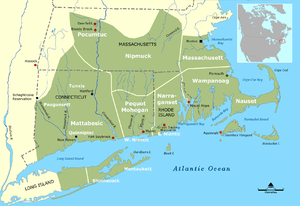Mohegan-Pequot language
| Mohegan-Pequot | |
|---|---|
| Native to | United States |
| Region | southern New England |
| Ethnicity | Mohegan, Montauk, Niantic, Pequot, and Shinnecock |
| Extinct | 1908, with the death of Fidelia Fielding |
|
Algic
|
|
| Language codes | |
| ISO 639-3 | |
| Glottolog | pequ1242 |

The location of the Mohegan, Pequot, Montaukett, Niantic, and Shinnecock, and their neighbors, c. 1600
|
|
Mohegan-Pequot (also known as Mohegan-Pequot-Montauk, Secatogue, Stockbridge, and Shinnecock-Poosepatuck; dialects include Mohegan, Pequot, Montauk, Niantic, and Shinnecock) is an extinct Algonquian language formerly spoken in parts of present-day New England and Long Island.
The Mohegan Indian Tribe was historically based in central southern Connecticut. While originally part of the Pequot people, it gradually became independent and served as allies of English colonists in the Pequot War of 1637, which broke the power of that formerly dominant tribe in the region. In reward, the English gave Pequot captives to the Mohegan.
In 1933 John E. Hamilton, also known as Chief Rolling Cloud, was appointed Grand Sachem for Life by his mother, Alice Storey, through the traditional selection process of chiefs based on heredity. She was a direct descendant of Uncas, the great 17th-century leader of the Mohegan Nation, and of Tamaquashad, Grand Sachem of the Pequot Nation. In Mohegan tradition, the position of tribal leadership called Grand Sachem had always been hereditary through the maternal line.
Gladys Tantaquidgeon, who died at the age of 106 in 2005, served for years as the Tribe's medicine woman and unofficial historian. She became an anthropologist and worked for a decade with the Bureau of Indian Affairs. Returning to Connecticut, she operated her family's tribal Tantaquidgeon Museum for more than 50 years, beginning in 1947. It was one of the first museums to be owned and operated by Native Americans.
John Hamilton was a key figure among Native American leaders initiating late twentieth century land claims suits. Tribes in the Northeast had long interaction with European Americans, which had resulted in many of them becoming nearly landless. Settlement of land claims suits in the late 20th and 21st centuries was related to federal recognition for a number of Indian nations, particularly for the so-called "state tribes." These were tribes along the East Coast who had been recognized by the English Crown long before individual colonial or state governments had been established. But, as the Native people lost their traditional lands and were not assigned reservations, they did not maintain their sovereign legal status associated with federal recognition.
...
Wikipedia
